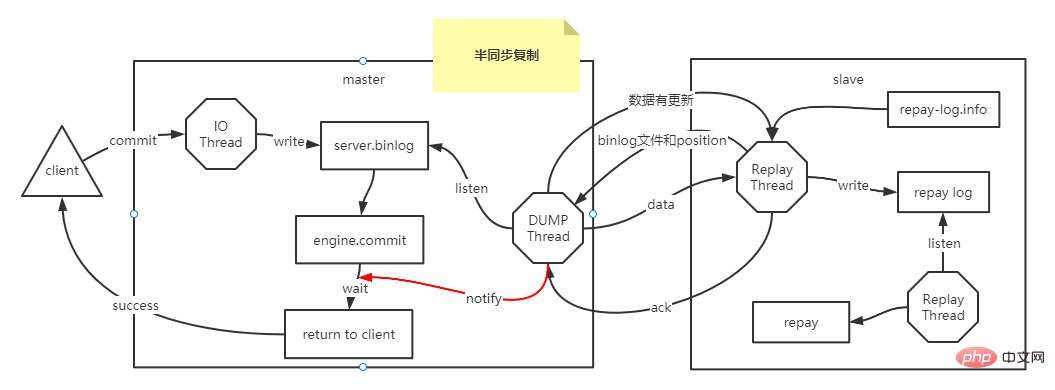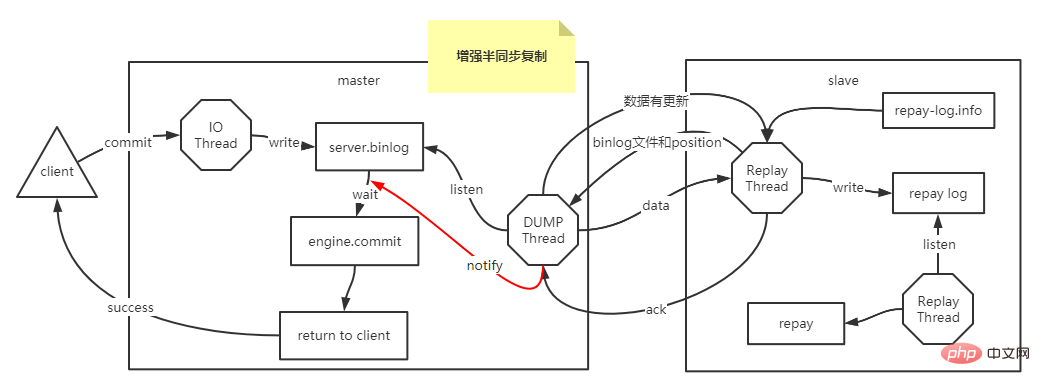 Database
Database
 Mysql Tutorial
Mysql Tutorial
 MySQL replication technology asynchronous replication and semi-synchronous replication
MySQL replication technology asynchronous replication and semi-synchronous replication
MySQL replication technology asynchronous replication and semi-synchronous replication
This article brings you relevant knowledge about mysql, which mainly introduces issues related to MySQL replication technology, including asynchronous replication, semi-synchronous replication, etc. Let’s talk about it together Take a look, hope it helps everyone.

Recommended learning: mysql video tutorial
Asynchronous replication
In asynchronous replication (async replication), the Master does not need to care whether the Slave receives the binary log, so the Master does not have any dependency on the Slave. You can think of the Master and Slave as two servers working independently, and the data will eventually be consistent through the binary log.
Asynchronous replication has the best performance because it has almost no overhead on the database itself, unless the master-slave delay is very large and the Dump Thread needs to read a large number of binary log files.
If the business does not have high requirements for data consistency and can tolerate data loss, or even a large amount of loss, when a failure occurs, it is recommended to use asynchronous replication, which has the best performance (for example, like Although businesses like Weibo have extremely high performance requirements, data loss can usually be tolerated). But often core business systems are most concerned about data security, such as monitoring services and alarm systems.
Planning of asynchronous replication environment:
master (docker), port 3310
- ##slave (docker), port 3311
$ sudo cat /home/mysql/docker-data/3311/conf/my.cnf # For advice on how to change settings please see # http://dev.mysql.com/doc/refman/5.7/en/server-configuration-defaults.html [mysqld] # # Remove leading # and set to the amount of RAM for the most important data # cache in MySQL. Start at 70% of total RAM for dedicated server, else 10%. # innodb_buffer_pool_size = 128M # # Remove leading # to turn on a very important data integrity option: logging # changes to the binary log between backups. # log_bin # # Remove leading # to set options mainly useful for reporting servers. # The server defaults are faster for transactions and fast SELECTs. # Adjust sizes as needed, experiment to find the optimal values. # join_buffer_size = 128M # sort_buffer_size = 2M # read_rnd_buffer_size = 2M #datadir=/home/mysql/docker-data/3307/data #socket=/home/mysql/docker-data/3307/mysql.sock character_set_server=utf8 init_connect='SET NAMES utf8' # Disabling symbolic-links is recommended to prevent assorted security risks symbolic-links=0 #log-error=/home/mysql/docker-data/3307/logs/mysqld.log #pid-file=/home/mysql/docker-data/3307/mysqld.pid lower_case_table_names=1 # 表名是否小写 server-id=1403311 log-bin=mysql-bin # 开启binlog binlog-format=ROW # binlog的格式 auto_increment_increment=1 # 自增的步长,适用于主主复制,为了避免id冲突,步长设置为master的个数 auto_increment_offset=1 # 自增的偏移,主主复制每个master的偏移需要不一致 # binlog-do-db=mstest # 要同步的数据库 # binlog-ignore-db=mysql # 要忽略的数据库 #rpl_semi_sync_master_enabled=1 #rpl_semi_sync_master_timeout=10000
$ docker run --name mysql3310 -p 3310:3306 --privileged=true -ti -e MYSQL_ROOT_PASSWORD=root -e MYSQL_DATABASE=order -e MYSQL_USER=user -e MYSQL_PASSWORD=pass -v /home/mysql/docker-data/3310/conf:/etc/mysql/conf.d -v /home/mysql/docker-data/3310/data/:/var/lib/mysql -v /home/mysql/docker-data/3310/logs/:/var/log/mysql -d mysql:5.7
mysql> GRANT REPLICATION SLAVE,FILE,REPLICATION CLIENT ON *.* TO 'repluser'@'%' IDENTIFIED BY '123456'; Query OK, 0 rows affected, 1 warning (0.01 sec) mysql> FLUSH PRIVILEGES; Query OK, 0 rows affected (0.01 sec)
mysql> show master status; +------------------+----------+--------------+------------------+-------------------+ | File | Position | Binlog_Do_DB | Binlog_Ignore_DB | Executed_Gtid_Set | +------------------+----------+--------------+------------------+-------------------+ | mysql-bin.000003 | 1147 | | | | +------------------+----------+--------------+------------------+-------------------+ 1 row in set (0.00 sec)
mysql> show processlist; +----+----------+------------------+-------+-------------+------+---------------------------------------------------------------+------------------+ | Id | User | Host | db | Command | Time | State | Info | +----+----------+------------------+-------+-------------+------+---------------------------------------------------------------+------------------+ | 2 | root | localhost | order | Query | 0 | starting | show processlist | | 6 | repluser | 172.17.0.1:48450 | NULL | Binlog Dump | 448 | Master has sent all binlog to slave; waiting for more updates | NULL | +----+----------+------------------+-------+-------------+------+---------------------------------------------------------------+------------------+ 2 rows in set (0.00 sec)
$ docker run --name mysql3311 -p 3311:3306 --privileged=true -ti -e MYSQL_ROOT_PASSWORD=root -e MYSQL_DATABASE=order -e MYSQL_USER=user -e MYSQL_PASSWORD=pass -v /home/mysql/docker-data/3311/conf:/etc/mysql/conf.d -v /home/mysql/docker-data/3311/data/:/var/lib/mysql -v /home/mysql/docker-data/3311/logs/:/var/log/mysql -d mysql:5.7
# master_log_file和master_log_pos取上面show master status显示的值mysql> change master to master_host='172.23.252.98',master_port=3310,master_user='repluser',master_password='123456',master_log_file='mysql-bin.000003',master_log_pos=1147;
mysql> start slave;Query OK, 0 rows affected (0.00 sec)
mysql> show slave status\G;*************************** 1. row ***************************
Slave_IO_State: Waiting for master to send event
Master_Host: 192.168.54.214
Master_User: repluser
Master_Port: 3310
Connect_Retry: 60
Master_Log_File: mysql-bin.000003
Read_Master_Log_Pos: 1147
Relay_Log_File: 2da789531bf3-relay-bin.000002
Relay_Log_Pos: 320
Relay_Master_Log_File: mysql-bin.000003
Slave_IO_Running: Yes
Slave_SQL_Running: Yes
Replicate_Do_DB:
Replicate_Ignore_DB:
Replicate_Do_Table:
Replicate_Ignore_Table:
Replicate_Wild_Do_Table:
Replicate_Wild_Ignore_Table:
Last_Errno: 0
Last_Error:
Skip_Counter: 0
Exec_Master_Log_Pos: 1147
Relay_Log_Space: 534
Until_Condition: None
Until_Log_File:
Until_Log_Pos: 0
Master_SSL_Allowed: No
Master_SSL_CA_File:
Master_SSL_CA_Path:
Master_SSL_Cert:
Master_SSL_Cipher:
Master_SSL_Key:
Seconds_Behind_Master: 0Master_SSL_Verify_Server_Cert: No
Last_IO_Errno: 0
Last_IO_Error:
Last_SQL_Errno: 0
Last_SQL_Error:
Replicate_Ignore_Server_Ids:
Master_Server_Id: 1403311
Master_UUID: cd2eaa0a-7a59-11ec-b3b4-0242ac110002
Master_Info_File: /var/lib/mysql/master.info
SQL_Delay: 0
SQL_Remaining_Delay: NULL
Slave_SQL_Running_State: Slave has read all relay log; waiting for more updates
Master_Retry_Count: 86400
Master_Bind:
Last_IO_Error_Timestamp:
Last_SQL_Error_Timestamp:
Master_SSL_Crl:
Master_SSL_Crlpath:
Retrieved_Gtid_Set:
Executed_Gtid_Set:
Auto_Position: 0
Replicate_Rewrite_DB:
Channel_Name:
Master_TLS_Version:1 row in set (0.00 sec)Only newly added data will be copied, and existing data needs to be synchronized manually using tools (such as mysqldump).View the process list on the slave:
mysql> show processlist; +----+-------------+-----------+-------+---------+------+--------------------------------------------------------+------------------+ | Id | User | Host | db | Command | Time | State | Info | +----+-------------+-----------+-------+---------+------+--------------------------------------------------------+------------------+ | 4 | root | localhost | order | Query | 0 | starting | show processlist | | 7 | system user | | NULL | Connect | 533 | Waiting for master to send event | NULL | | 8 | system user | | NULL | Connect | 127 | Slave has read all relay log; waiting for more updates | NULL | +----+-------------+-----------+-------+---------+------+--------------------------------------------------------+------------------+ 3 rows in set (0.00 sec)
Semi-synchronous replication
Semi-synchronous replication is the semi-synchronous replication before MySQL 5.7 version mechanism.
Enhanced semi-synchronous replication
Enhanced semi-synchronous replication solves the shortcomings of semi-synchronous replication. WAIT and ACK occur before the transaction is committed, so that even if the Slave does not receive the binary Log, but the Master is down. Since the last transaction has not been submitted, the data itself is not visible to the outside world, and there is no problem of loss.
# master mysql> install plugin rpl_semi_sync_master soname 'semisync_master.so'; # slave mysql> install plugin rpl_semi_sync_slave soname 'semisync_slave.so';
mysql> show plugins; ... ... | rpl_semi_sync_master | ACTIVE | REPLICATION | semisync_master.so | GPL | | rpl_semi_sync_slave | ACTIVE | REPLICATION | semisync_slave.so | GPL | +----------------------------+----------+--------------------+--------------------+---------+ 46 rows in set (0.00 sec)
mysql> set global rpl_semi_sync_slave_enabled = {0|1}; # 1:启用,0:禁止mysql> set global rpl_semi_sync_master_enabled = {0|1}; # 1:启用,0:禁止
# mysql> set global rpl_semi_sync_master_timeout = 10000; # 单位为ms,默认为10smysql> stop slave io_thread; mysql> start slave io_thread;
If the parameters are written into the configuration file, the instance will enter semi-synchronous mode immediately after startup. If an instance that has been disconnected for a long time is re-started, it may cause the main database to be brought down. After reconnecting the slave database that has been disconnected for a long time, you must wait for all transactions to be traced and then manually turn on the semi-synchronous mode instead of switching directly after startup to prevent impact on the main database. Query main database status information
mysql> show global status like "%semi%";
+--------------------------------------------+-------+
| Variable_name | Value |
+--------------------------------------------+-------+
| Rpl_semi_sync_master_clients | 0 |
| Rpl_semi_sync_master_net_avg_wait_time | 0 |
| Rpl_semi_sync_master_net_wait_time | 0 |
| Rpl_semi_sync_master_net_waits | 0 |
| Rpl_semi_sync_master_no_times | 0 |
| Rpl_semi_sync_master_no_tx | 0 |
| Rpl_semi_sync_master_status | ON |
| Rpl_semi_sync_master_timefunc_failures | 0 |
| Rpl_semi_sync_master_tx_avg_wait_time | 0 |
| Rpl_semi_sync_master_tx_wait_time | 0 |
| Rpl_semi_sync_master_tx_waits | 0 |
| Rpl_semi_sync_master_wait_pos_backtraverse | 0 |
| Rpl_semi_sync_master_wait_sessions | 0 |
| Rpl_semi_sync_master_yes_tx | 0 |
| Rpl_semi_sync_slave_status | ON |
+--------------------------------------------+-------+
15 rows in set (0.00 sec)
Copy after login
Important parameter description:mysql> show global status like "%semi%"; +--------------------------------------------+-------+ | Variable_name | Value | +--------------------------------------------+-------+ | Rpl_semi_sync_master_clients | 0 | | Rpl_semi_sync_master_net_avg_wait_time | 0 | | Rpl_semi_sync_master_net_wait_time | 0 | | Rpl_semi_sync_master_net_waits | 0 | | Rpl_semi_sync_master_no_times | 0 | | Rpl_semi_sync_master_no_tx | 0 | | Rpl_semi_sync_master_status | ON | | Rpl_semi_sync_master_timefunc_failures | 0 | | Rpl_semi_sync_master_tx_avg_wait_time | 0 | | Rpl_semi_sync_master_tx_wait_time | 0 | | Rpl_semi_sync_master_tx_waits | 0 | | Rpl_semi_sync_master_wait_pos_backtraverse | 0 | | Rpl_semi_sync_master_wait_sessions | 0 | | Rpl_semi_sync_master_yes_tx | 0 | | Rpl_semi_sync_slave_status | ON | +--------------------------------------------+-------+ 15 rows in set (0.00 sec)
- Rpl_semi_sync_master_clients:支持和注册半同步复制的已连Slave数
- Rpl_semi_sync_master_no_times:master关闭半同步复制的次数
- Rpl_semi_sync_master_no_tx:master没有收到slave的回复而提交的次数,可以理解为master等待超时的次数,即半同步模式不成功提交数量
- Rpl_semi_sync_master_status:ON是活动状态(半同步),OFF是非活动状态(异步),用于表示主服务器使用的是异步复制模式,还是半同步复制模式
- Rpl_semi_sync_master_tx_avg_wait_time:master花在每个事务上的平均等待时间
- Rpl_semi_sync_master_tx_waits:master等待成功的次数,即master没有等待超时的次数,也就是成功提交的次数
- Rpl_semi_sync_master_yes_tx:master成功接收到slave的回复的次数,即半同步模式成功提交数量。
查询主库参数信息
mysql> show global variables like '%sync%'; +-------------------------------------------+------------+ | Variable_name | Value | +-------------------------------------------+------------+ | binlog_group_commit_sync_delay | 0 | | binlog_group_commit_sync_no_delay_count | 0 | | innodb_flush_sync | ON | | innodb_sync_array_size | 1 | | innodb_sync_spin_loops | 30 | | rpl_semi_sync_master_enabled | ON | | rpl_semi_sync_master_timeout | 10000 | | rpl_semi_sync_master_trace_level | 32 | | rpl_semi_sync_master_wait_for_slave_count | 1 | | rpl_semi_sync_master_wait_no_slave | ON | | rpl_semi_sync_master_wait_point | AFTER_SYNC | | rpl_semi_sync_slave_enabled | ON | | rpl_semi_sync_slave_trace_level | 32 | | sync_binlog | 1 | | sync_frm | ON | | sync_master_info | 10000 | | sync_relay_log | 10000 | | sync_relay_log_info | 10000 | +-------------------------------------------+------------+ 18 rows in set (0.01 sec)
重要参数说明:
- rpl_semi_sync_master_enabled:(主库)是否启动半同步
- rpl_semi_sync_master_timeout:等待多时毫秒后变成异步复制,默认是10000ms
- rpl_semi_sync_master_wait_point:5.7默认AFTER_SYNC(增强版半同步复制,无损复制模式),在得到slave的应答后再commit,可选值AFTER_COMMIT,在master提交后同步数据给slave,然后master等待slave应答,应答成功返回客户端。
可以在slave端执行stop slave,测试master端会发生什么情况?
在master上执行下面的sql:
mysql> insert into t_order values(3,"C");Query OK, 1 row affected (10.05 sec)
会发现这条语句会阻塞10s(对应上面的参数rpl_semi_sync_master_timeout),然后执行成功,最后看看看master的日志描述:
2022-01-25T02:31:57.016430Z 4 [Note] Start binlog_dump to master_thread_id(4) slave_server(1403312), pos(mysql-bin.000005, 154) 2022-01-25T02:31:57.016515Z 4 [Note] Start asynchronous binlog_dump to slave (server_id: 1403312), pos(mysql-bin.000005, 154) 2022-01-25T02:33:32.183819Z 2 [Note] Semi-sync replication initialized for transactions. 2022-01-25T02:33:32.183865Z 2 [Note] Semi-sync replication enabled on the master. 2022-01-25T02:33:32.184004Z 0 [Note] Starting ack receiver thread 2022-01-25T02:33:59.644444Z 5 [Note] While initializing dump thread for slave with UUID <aba2eb12-7cbc-11ec-9c1d-0242ac110003>, found a zombie dump thread with the same UUID. Master is killing the zombie dump thread(4). 2022-01-25T02:33:59.644612Z 5 [Note] Start binlog_dump to master_thread_id(5) slave_server(1403312), pos(mysql-bin.000005, 154) 2022-01-25T02:33:59.644632Z 4 [Note] Stop asynchronous binlog_dump to slave (server_id: 1403312) 2022-01-25T02:33:59.644727Z 5 [Note] Start semi-sync binlog_dump to slave (server_id: 1403312), pos(mysql-bin.000005, 154) 2022-01-25T02:38:02.847879Z 0 [ERROR] mysqld: Got an error reading communication packets 2022-01-25T02:38:27.228952Z 2 [Warning] Timeout waiting for reply of binlog (file: mysql-bin.000005, pos: 684), semi-sync up to file mysql-bin.000005, position 419. 2022-01-25T02:38:27.229063Z 2 [Note] Semi-sync replication switched OFF. 2022-01-25T02:39:47.230189Z 5 [Note] Stop semi-sync binlog_dump to slave (server_id: 1403312)
可以发现半同步关闭了,变成异步模式。
推荐学习:mysql视频教程
The above is the detailed content of MySQL replication technology asynchronous replication and semi-synchronous replication. For more information, please follow other related articles on the PHP Chinese website!

Hot AI Tools

Undresser.AI Undress
AI-powered app for creating realistic nude photos

AI Clothes Remover
Online AI tool for removing clothes from photos.

Undress AI Tool
Undress images for free

Clothoff.io
AI clothes remover

Video Face Swap
Swap faces in any video effortlessly with our completely free AI face swap tool!

Hot Article

Hot Tools

Notepad++7.3.1
Easy-to-use and free code editor

SublimeText3 Chinese version
Chinese version, very easy to use

Zend Studio 13.0.1
Powerful PHP integrated development environment

Dreamweaver CS6
Visual web development tools

SublimeText3 Mac version
God-level code editing software (SublimeText3)

Hot Topics
 MySQL: An Introduction to the World's Most Popular Database
Apr 12, 2025 am 12:18 AM
MySQL: An Introduction to the World's Most Popular Database
Apr 12, 2025 am 12:18 AM
MySQL is an open source relational database management system, mainly used to store and retrieve data quickly and reliably. Its working principle includes client requests, query resolution, execution of queries and return results. Examples of usage include creating tables, inserting and querying data, and advanced features such as JOIN operations. Common errors involve SQL syntax, data types, and permissions, and optimization suggestions include the use of indexes, optimized queries, and partitioning of tables.
 MySQL's Place: Databases and Programming
Apr 13, 2025 am 12:18 AM
MySQL's Place: Databases and Programming
Apr 13, 2025 am 12:18 AM
MySQL's position in databases and programming is very important. It is an open source relational database management system that is widely used in various application scenarios. 1) MySQL provides efficient data storage, organization and retrieval functions, supporting Web, mobile and enterprise-level systems. 2) It uses a client-server architecture, supports multiple storage engines and index optimization. 3) Basic usages include creating tables and inserting data, and advanced usages involve multi-table JOINs and complex queries. 4) Frequently asked questions such as SQL syntax errors and performance issues can be debugged through the EXPLAIN command and slow query log. 5) Performance optimization methods include rational use of indexes, optimized query and use of caches. Best practices include using transactions and PreparedStatemen
 How to connect to the database of apache
Apr 13, 2025 pm 01:03 PM
How to connect to the database of apache
Apr 13, 2025 pm 01:03 PM
Apache connects to a database requires the following steps: Install the database driver. Configure the web.xml file to create a connection pool. Create a JDBC data source and specify the connection settings. Use the JDBC API to access the database from Java code, including getting connections, creating statements, binding parameters, executing queries or updates, and processing results.
 Why Use MySQL? Benefits and Advantages
Apr 12, 2025 am 12:17 AM
Why Use MySQL? Benefits and Advantages
Apr 12, 2025 am 12:17 AM
MySQL is chosen for its performance, reliability, ease of use, and community support. 1.MySQL provides efficient data storage and retrieval functions, supporting multiple data types and advanced query operations. 2. Adopt client-server architecture and multiple storage engines to support transaction and query optimization. 3. Easy to use, supports a variety of operating systems and programming languages. 4. Have strong community support and provide rich resources and solutions.
 How to start mysql by docker
Apr 15, 2025 pm 12:09 PM
How to start mysql by docker
Apr 15, 2025 pm 12:09 PM
The process of starting MySQL in Docker consists of the following steps: Pull the MySQL image to create and start the container, set the root user password, and map the port verification connection Create the database and the user grants all permissions to the database
 MySQL's Role: Databases in Web Applications
Apr 17, 2025 am 12:23 AM
MySQL's Role: Databases in Web Applications
Apr 17, 2025 am 12:23 AM
The main role of MySQL in web applications is to store and manage data. 1.MySQL efficiently processes user information, product catalogs, transaction records and other data. 2. Through SQL query, developers can extract information from the database to generate dynamic content. 3.MySQL works based on the client-server model to ensure acceptable query speed.
 Laravel Introduction Example
Apr 18, 2025 pm 12:45 PM
Laravel Introduction Example
Apr 18, 2025 pm 12:45 PM
Laravel is a PHP framework for easy building of web applications. It provides a range of powerful features including: Installation: Install the Laravel CLI globally with Composer and create applications in the project directory. Routing: Define the relationship between the URL and the handler in routes/web.php. View: Create a view in resources/views to render the application's interface. Database Integration: Provides out-of-the-box integration with databases such as MySQL and uses migration to create and modify tables. Model and Controller: The model represents the database entity and the controller processes HTTP requests.
 How to install mysql in centos7
Apr 14, 2025 pm 08:30 PM
How to install mysql in centos7
Apr 14, 2025 pm 08:30 PM
The key to installing MySQL elegantly is to add the official MySQL repository. The specific steps are as follows: Download the MySQL official GPG key to prevent phishing attacks. Add MySQL repository file: rpm -Uvh https://dev.mysql.com/get/mysql80-community-release-el7-3.noarch.rpm Update yum repository cache: yum update installation MySQL: yum install mysql-server startup MySQL service: systemctl start mysqld set up booting






